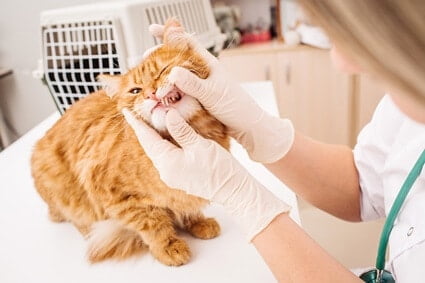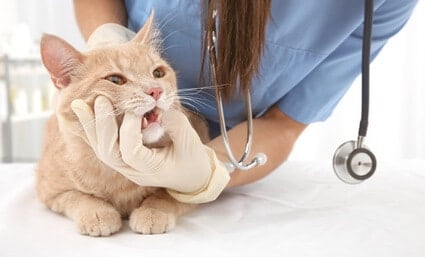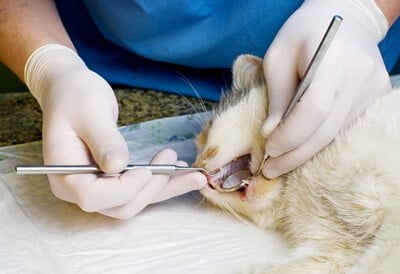Dental problems (toothache, abscesses, bad teeth, inflamed gums, or a broken tooth) are common in cats. Most felines will experience tooth decay or gum disease at some stage, leaving the cat reluctant to eat as it hurts to do so.
A cat refusing to eat due to teeth problems should be fed wet food. Break down the food into small chunks to minimize chewing. Liquid food is fine as a short-term measure, as long as it’s nutritious. Manage your cat’s pain and tempt it to eat with enticing meat-based flavors and scents.
Some cats avoid teeth problems when a good oral health regime is maintained, but most cats will experience problems. Dental issues often manifest in the first 3 years or as the cat gets older.
Does My Cat Have Toothache?
Sometimes, eating is too painful for the cat to contemplate. However, there are other warning signs:
- Visible plaque, tartar, and staining on the teeth
- Drooling, especially from one side of the face
- Pawing at the face
- Foul breath
- Refusing to play with toys
- Gum discoloration
- Bleeding gums
- Swelling around the tongue
- An aggressive response to being touched on the face
Obvious physical symptoms include cracked and broken teeth or tooth loss. Understanding the different types of dental pain that can impact cats is critical.
Feline oral pain has various causes, including:
Gingivitis
Gingivitis is the inflammation of a cat’s gums. As with all forms of inflammation, this will lead to painful swelling. This, in turn, will mean that your cat’s teeth will hurt.
Gingivitis is caused by the build-up of plaque on a cat’s teeth. Plaque is a filmy coating that sticks to the teeth after eating. This film attracts bacteria, which quickly multiply.
These bacteria head to the gums, eventually migrating below the surface. Inflammation is triggered by the immune system responding to this problem. If the swelling is more generalized, spreading to the tongue, this is stomatitis.
As explained by The Journal of Nutrition, gingivitis can be avoided by regularly brushing the teeth. Even after it arises, gingivitis can be reversed at an early stage. Once it takes hold, it rapidly worsens, leading to periodontitis.
Periodontal Disease
Unchecked gingivitis will advance to periodontal disease, a more serious form of inflammation.
Just brushing the teeth won’t be effective once the condition worsens. This means your cat will, at a minimum, require a professional tooth cleaning.
Even after this, teeth may need to be removed due to irreparable damage. Also, antibiotics will be required to get rid of a bacterial infection.
Tooth Resorption
Feline tooth resorption arises when the tooth’s integrity deteriorates, leading to cavities.
The lower teeth are most commonly impacted by tooth resorption. A study of 109 cases by the Journal of Veterinary Dentistry found that purebreds are likeliest to be affected.
You may notice a cavity growing over the tooth. In the latter case, an x-ray will be required for diagnosis. In the event of tooth resorption, extraction is the only solution.
Cracks And Fractures
Cats’ teeth can become cracked or broken. This may occur due to eating hard food, especially in older cats. As cats age, their teeth and bones become more brittle. Also, an impact injury can lead to broken teeth.
Broken teeth are painful because the root of the tooth is unprotected, exposing the nerve endings. Also, the fractured tooth may have jagged edges that lead to a sore tongue and gums.

Abscesses
If your cat has a broken tooth, an abscess may follow. Bacteria enter the tooth’s root canal that was exposed by the fracture.
These bacteria cause inflammation in the tooth, which is called pulpitis. Over time, the tooth will rot and die, known as pulp necrosis. Bacteria can also leak from the exposed tooth, rotting other teeth and bones.
This can result in a build-up of pus. It can be controlled with antibiotics, but the tooth will need to be removed. Other teeth that are impacted may also need to be extracted.
Malocclusions
As explained by BMJ InPractice, malocclusions occur when a cat’s teeth are in unnatural positions.
This is usually the result of a birth defect or trauma to the lower jaw. Broken bones may heal organically, but they can grow misaligned without appropriate treatment.
This will lead to an overbite or underbite. The cat will be unable to close its mouth without biting its tongue or gums.
Malocclusions are easy to identify via an oral examination. If a malocclusion is diagnosed, certain teeth will be extracted, or orthodontics used to reposition teeth.
Cat is Not Eating Due To Bad Teeth
If your cat struggles to eat due to dental issues, its life is in danger. Cats can only survive 3-4 days without eating. Anything longer than 24 hours is risky, especially in older felines.
If tooth issues prevent a cat from eating, encourage it to eat something, even if it’s less than usual. Also, seek assistance from a vet to resolve the cat’s dental pain.
Encouraging a Cat To Eat
Cats can be stubborn at the best of times, but you must do all you can to get your cat to eat some food. Leaving your cat alone and hoping it changes its mind about eating isn’t an option at this stage.
Pain Management
Your cat’s inappetence is related to the discomfort caused by eating.
Never offer human painkillers to a cat, such as aspirin or ibuprofen. The British Veterinary Journal has made it clear that these drugs are toxic to felines.
You’ll need a prescription for pain relief medication from a vet. These meds will be Non-Steroidal Anti-Inflammatory Drugs or NSAIDs. No NSAID is approved for prolonged use in cats, so it is a short-term measure only.
Brushing Teeth
Brushing a cat’s teeth is standard practice as it reduces the risk of gingivitis and the conditions that follow. Even if plaque has started to form, brushing can reverse the issue if caught early.
You’ll need a finger-mounted brush and cat-safe toothpaste to brush a cat’s teeth. Fluoride, the active ingredient in human toothpaste, is toxic to felines when ingested.
Gently brush your cat’s teeth, paying particular attention to the gum line, as this is where bacteria gather. If your cat grows uncomfortable, take a break and return later.
Appetite Stimulants
You can deal with inappetence with natural appetite stimulants. Your local pet store will have over-the-counter appetite stimulants, such as Nutri-Cal, Lexelium, and Nutri-Vit.
Tempting Food
You can increase your cat’s appetite by appealing to its sense of smell: drizzle tuna juice or gravy over the food. Keep the food soft. The less resistance your cat’s teeth meet, the more willing it’ll be to bite off and chew its food.
Cats with dental pain should be fed senior-specific wet food. These meals are intended for cats with weaker teeth. Alternatively, feed your cat soup or broth. In an emergency, a cat can eat human baby food.
Treating Tooth Problems
Encouraging your cat to eat during dental pain is important, but the underlying issue still needs to be resolved. You’ll need assistance from a vet to resolve the problem.
One of three approaches will be taken:
Cleaning
Professional tooth cleaning under anesthesia is the first step to treating dental issues. However, there are risks associated with teeth cleaning for senior cats.
Embedded plaque and tartar will be from the teeth using specialist tools. The cat will leave the surgery with clean, healthy teeth.
If your cat’s dental issues are minor, tooth cleaning will be effective. In more advanced cases of tooth decay, teeth may need to be extracted.
Tooth Extraction
Removing a cat’s teeth is a painful, intrusive procedure. Your cat will be placed under general anesthesia and the teeth removed.
A vet will discuss options with you before resorting to tooth extraction. It may be possible for a vet to perform fillings or root canal surgery. In cases of advanced periodontal disease, extraction is the only choice.
It may take about 14 days before your cat is back to its usual self.
Orthodontics
If tooth removal is impossible or unnecessary, a vet may apply orthodontics.
These are braces that realign a cat’s teeth. This approach is likely if several teeth need to be adjusted, and it’s less intrusive than multiple extractions.
Orthodontics can be expensive and require careful maintenance. You must regularly brush your cat’s teeth, or food will become trapped in the braces.
Your cat will need regular check-ups to tighten the braces.

My Cat Had Teeth Removed and Won’t Eat
Tooth removal is a painful procedure that requires anesthesia. Your cat is unlikely to be hungry when it returns home.
Offer your cat affection, and give your cat painkilling medications prescribed by a vet. After 12 hours, tempt your cat into eating again. Tempting scents and soft food are essential. Keep offering your cat encouragement, as it may take a while for your cat to trust food again.
If your cat refuses to eat after 24 hours, consult your vet. The cat may be experiencing side effects from the tooth extraction, and your cat may require intravenous nourishment while it recovers.
My Cat Won’t Eat After Teeth Cleaning
If your cat underwent a professional tooth cleaning, it was likely anesthetized. This can have a significant impact on a cat’s appetite. It may also be grumpy and irritable for a few hours afterward.
The side effects of anesthesia should wear off the day you bring your cat home. Be patient and keep offering food. Don’t force your cat to eat.
Ensure that the meal is soft and flavorful. The cat will be wary of food, recalling the pain that eating its meal previously caused. Once the cat regains its appetite, it will commence eating.
My Cat with No Teeth Won’t Eat
If dental problems become chronic, your cat may need all its teeth removed.
Offer your cat the softest wet food that you can find. Most senior cat foods are designed to be swallowed with minimal chewing. Keep tempting your cat with meaty scents and encouragement.
If your cat refuses to eat wet food, it can still enjoy kibble. Break the kibble chunks in half or grind them down. Apply a feline-friendly gravy to the kibble and serve it as a stew.
This approach can also be applied to whole foods, such as chicken or fish. Place the food in a blender and puree it. However, a cat, especially if it’s advanced in years, should always eat traditional cat food.
A cat experiencing dental problems will understandably be reluctant to eat. You must recognize the symptoms of tooth problems, consult a vet, and provide a makeshift diet that takes into account the condition of the teeth.


Hi Richard,
I’m having a problem with my cat refusing to eat,due to her gums being inflamed,I believe she has gingivitis.
What would you suggest to try that would help? Thanks!